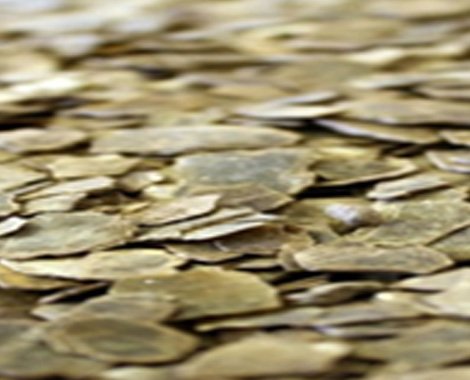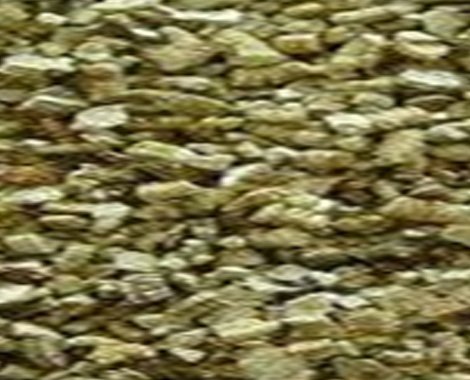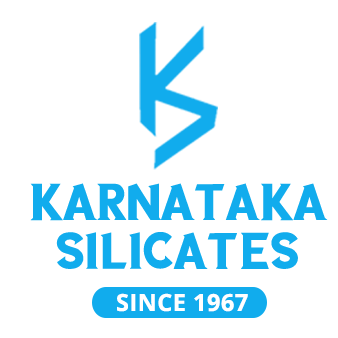RAW VERMICULITE
Vermiculite is a member of the phyllosilicate group of minerals, resembling mica in appearance. It is found in various parts of the world, but the details given here relate to the our deposits mined in the Mysore region of the Karnataka ,Vermiculite is basically a hydrated phlogopite mica which has the remarkable ability to expand to many times its original volume when heated, a property known as exfoliation. Various chemical formulae are given for vermiculite. The general formula given below suggests a typical formula, which has been calculated from 65 vermiculite analyses.
Raw/ Crude Vermiculite
Raw/Crude vermiculite from the mine consists of golden / brown / silver, flakes which are carefully classified into Different grades – each having a specified range of particle sizes. The coarsest grade comprises particles ranging between 1mm and 7mm, while the finest grade consists of particles between 0.710mm and 0.250mm in size. The loose bulk density of crude Vermiculite varies with the grade, but is typically between 700 and 1050 kg/m3.
Exfoliated Vermiculite
The exfoliation process is carried out commercially by passing crude vermiculite through a furnace chamber in a controlled manner. The crude vermiculite then expands at right angles to the cleavage planes, producing concertina-shaped particles many times their original volume.
Why does vermiculite exfoliate?
The interlayer water is an essential component in the vermiculite. When a particle of vermiculite is rapidly heated, the interlayer crystalline water transforms into steam. The pressure of this steam evolution, forces the silicate layers apart from one another and the vermiculite flake forms an elongate concertina like particle twenty to thirty times its original thickness.


Specifications :
Raw Crude Vermiculite from the mine consists of golden to brown flakes which are carefully classified into five grades – each with a specified range of particle sizes, as detailed in the table below:
|
Grade |
Particle size distributionmin. 80% retained (mm) |
Loose bulkDensity kg/m3 |
|
LARGE |
-8.0 + 2.8 |
700 – 850 |
|
MEDIUM |
-4.0 + 1.4 |
800 – 950 |
|
FINE |
-2.0 + 0.710 |
850 – 1050 |
|
SUPERFINE |
-1.0 + 0.355 |
850 – 1050 |
|
MICRON |
-0.710 + 0.250 |
850 – 1050 |
Exfoliated Vermiculite:
Vermiculite is most widely used in its exfoliated form. The concertina-shaped granules of exfoliated vermiculite are non-combustible as well as being insoluble in water and all organic solvents. Safe and easy to handle, exfoliated vermiculite is available in the market place in five different grades as shown in the table below:
Volume Yields For Exfotliated Vermiculite:
|
Grade |
Typical loose bulkdensities of product (kg/m3) |
per ton of crudevermiculite processed (m3) |
|
MICRON |
105 – 135 |
7.5 – 9.0 |
|
SUPERFINE |
85 – 100 |
8.5 – 10.0 |
|
FINE |
75 – 85 |
10.5 – 11.5 |
|
MEDIUM |
70 – 85 |
11.5 – 13.0 |
Chemical Analysis:
|
Typical Ranges for Major Components |
|
|
SiO2 |
35 – 41% |
|
Al2O3 |
6.0 – 10.0% |
|
Fe2O3 |
6.0 – 9.5% |
|
MgO |
21.5 – 25.5% |
|
K2O |
3.0 – 6.0% |
|
Typical Ranges for Minor Components |
|
|
CaO |
2.0 – 6.0% |
|
CO2 |
0.6 – 2.5% |
|
TiO2 |
0.6 – 1.4% |
|
F |
0.2 – 0.8% |
|
Cr2O3 |
0.01 – 0.10% |
|
P |
0.2 – 2.0% |
|
Cl |
0 – 0.5% |
|
Angle of Repose |
– |
38º to 26º according to grade |
|
Specific Heat |
– |
1.03 kJ.K. at 20ºC 1.05kJ/kg.K. at 30ºC |
|
Specific Gravity |
– |
2.5 to 2.6 depending on the grade |
|
Mohs Hardness |
– |
Between 1 & 2 |
|
pH Value |
– |
8.5 to 10 |
|
Weight Loss |
– |
At 105ºC – 4.5 to 6.5%. At 95ºC – 8.0 – 10.0% |
Applications:
- FIRE PROOFING
- FRICTION LININGS
- AGRICULTURE
- BUILDINGS & CONSTRUCTIONS
- ENERGY CONSERVATION
- VERMICULITE COATED FIBER GLASS
- VERMICULITE BLOCKS AND BOARDS
- PURIFICATION & ADSORBENTS
- IRON & STEEL CASTINGS AND REFRACTORY PRODUCTS
- ACOUSTIC INSULATION
- VERMICULITE PLASTERS

